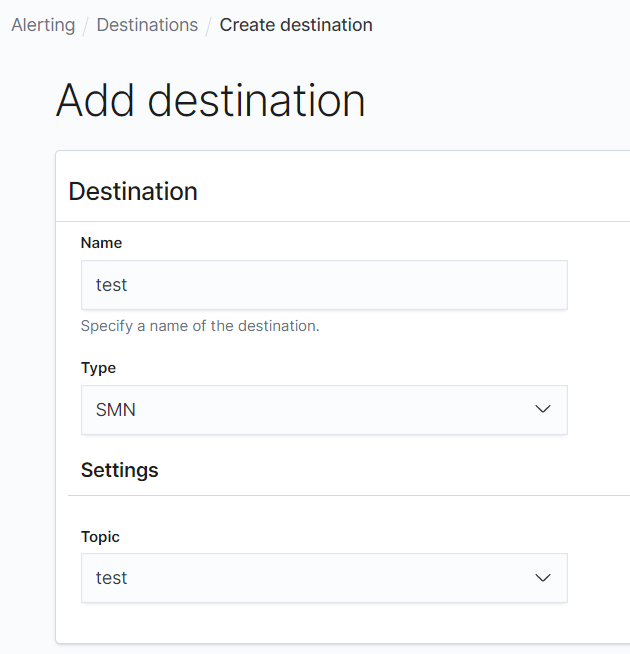Configuring SMN Alarms¶
Scenarios¶
By default, CSS has installed the open-source alert plugin opensearch-alerting for OpenSearch clusters to send notifications when data meets specific conditions. This plugin consists of three components: Alerts, Monitors, and Destinations. CSS integrates the SMN service in the Destinations component and can send alarm messages only through the SMN service as the destination.
This section describes how to configure the SMN alarm function for OpenSearch clusters on OpenSearch Dashboards.
Note
For details about the official guide of the plug-in OpenSearch Alerting, visit Alerting - OpenSearch Documentation.
Constraints and Limitations¶
By default, the open-source alert plug-in opensearch-alerting is installed for OpenSearch clusters of version 1.3.6.
Prerequisites¶
The SMN service has been authorized. For details, see (Optional) Authorizing CSS to Use SMN.
You have created a topic on the SMN console.
Procedure¶
Log in to the CSS management console.
Choose Clusters > OpenSearch, select the target cluster and click Access Kibana in the Operation column.
On the OpenSearch Dashboards page, choose OpenSearch Plugins > Alerting in the navigation tree on the left.
Create an SMN destination to send alert messages.
On the Alerting page, click the Destinations tab and click Add destination to configure destination information.
Table 1 Destinations parameters¶ Parameter
Description
Name
User-defined destination name
Type
Retain the default value SMN.
Topic
Select the SMN topic you have created for sending alarm messages.

Figure 1 Add destination¶
Click Create to return to the destination list. The created SMN destination is displayed in the list.

Figure 2 Destination list¶
Create a monitoring task and configure the alarm triggering condition and monitoring frequency.
Click the Monitors tab on the Alerting page and click Create monitor to configure monitoring information.
Table 2 Monitor parameters¶ Parameter
Description
Monitor details
Monitor name
User-defined monitor name
Monitor type
Monitor type. The value can be Per query monitor (common monitoring), Per bucket monitor (aggregation bucket monitoring), and Per cluster metrics monitor (cluster metric monitoring).
Monitor defining method
Monitor defining method. Extraction query editor is recommended.
Visual editor
Extraction query editor
Anomaly detector
The options of Monitor defining method are determined by the Monitor type you selected.
Detector
If Monitor defining method is set to Anomaly detector, select an exception detection task.
Frequency
Select the monitoring frequency and set the monitoring interval. The options include:
By interval
Daily
Weekly
Monthly
Custom cron expression
Data source
Index
When Monitor defining method is set to Visual editor or Extraction query editor, you need to specify the index to be monitored.
Time field
When Monitor defining method is set to Visual editor, you need to specify the time field to define counting parameters such as count.
Query
Metrics
When Monitor defining method is set to Visual editor, you need to set the metrics range for extracting statistics.
Time range for the last
When Monitor defining method is set to Visual editor, you need to set the monitoring time range for plug-ins.
Data filter
When Monitor defining method is set to Visual editor, you need to set filters for data search.
Group by
When Monitor defining method is set to Visual editor, you need to specify a field so that each value of the field triggers an alarm.
Define extraction query
When Monitor defining method is set to Extraction query editor, you need to enter the query statement to define the monitoring.
Request type
When Monitor type is set to Per cluster metrics monitor, you need to specify the request type to monitor cluster metrics, such as the running status and CPU usage.
Click Add trigger to add triggers and specify the alarm triggering conditions and actions to be triggered when an alarm is reported.
On the Triggers page, set the alarm triggering sensitivity and message release on the destination end.
Table 3 Trigger parameters¶ Parameter
Description
Trigger name
User-defined trigger name
Severity level
Sensitivity of a trigger, that is, the number of alarms that are triggered before an alarm message is sent. 1 indicates the highest sensitivity.
Trigger condition
Trigger condition. An alarm is triggered when the trigger condition is hit.
Action name
Trigger action name
Destination
Select the SMN destination created in section 4.
Message
Alarm message body By default, the subject and body are defined when the destination is an email.
Perform action
When Monitor type is set to Per bucket monitor, you need to set whether to send alarms in combination. The value can be:
Per execution: A combination alarm is sent when multiple alarm triggering conditions are hit.
Per alert: Alarms are sent separately when multiple alarm triggering conditions are hit.
Actionable alerts
When Monitor type is set to Per bucket monitor, set this parameter to Per alert. You need to set the alarms that can be executed after alarm triggering conditions are hit.
De-duplicated: Alarms that have been triggered. OpenSearch retains the existing alarms to prevent the plugin from creating duplicate alarms.
New: Newly created alarms.
Completed: Alarms that are no longer ongoing.
Throttling
Message sending frequency. It limits the number of notification messages can be received in a specified period.
For example, if this parameter is set to 10 minutes, SMN sends only one alarm notification in the next 10 minutes even if the trigger condition is hit for multiple times. After 10 minutes, SMN sends another alarm notification if the alarm condition is met.

Figure 3 Setting the destination of a trigger action¶
Click Send test message. If a subscriber receives an email, as shown in Figure 5, the trigger is configured successfully.

Figure 4 Sending a test message¶

Figure 5 Email notification¶
Click Create to return to the monitor details page. The detector is successfully created.